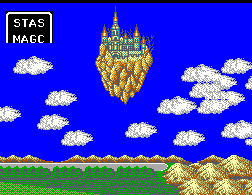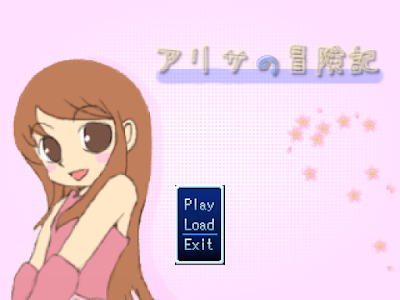Phantasy Star
Phantasy Star, Sega
1987, Sega Mk. III / Sega Master System
I played this game because it was an early and popular DRPG, but I'm not sure it makes sense to evaluate it as one. It's more like a Dragon Quest II clone with first-person dungeons: much of one's time is spent on the overworlds or in (2D, fully explorable) towns; the dungeons are many and small, not few and labyrinthine; and so on. You could almost call it a spiritual successor to Ultima 1 given the science-fantasy setting, 3D dungeons paired with a 2D overworld, multiple land vehicles, and corridor-based dungeons, but the turn-based combat makes the comparison feel a bit inapt: it's a JRPG through and through.
Combat pits the party of 1-4, initially Alis alone but growing to include Myau, Odin, and Noah, against a group of enemies. Unusually, there's never more than one type of monster in the group, or even stat variance between monsters of the same type. Battles, therefore, are as simple and unstrategic as the one-on-one fights of Dragon Quest I or Deep Dungeon (you can't even target individual members of the enemy group) while taking as much time as the party-vs.-party of Dragon Quest II et al. This is an incredible recipe for tedium! There's nothing to do besides mash Attack on all characters, round after round (and fights often take several rounds); attack magic exists, but is too weak and expensive to be worth using in random encounters. Even Noah, whose physical attacks are piddly, is better-served saving his MP for healing spells. For area-of-effect damage I relied on Odin, who cannot cast spells but can equip guns, alternative weapons which inflict fixed damage on every enemy and never miss. Also, whenever an enemy attacks, it makes this awful, prolonged, Atari-esque buzzing sound. The music is fine, the other sound effects are fine, but this one sound effect that plays constantly is unbearable; it's bizarre.
Enemies always drop treasure chests, which contain gold and sometimes an item. These chests are often trapped with either a spear (moderate damage to one party member) or a bomb (moderate damage to all party members); you can choose not to open the chest, which takes you to the interaction menu, where I presume the Search command and Myau's TRAP spell let you find and remove the trap, but this takes so much longer than just pressing A and eating the trap that I didn't even bother testing it (as, once again, literally every encounter drops a treasure chest). A further annoyance is that most enemies' chests have a high chance to contain a FLASH, a consumable item that lights up the dungeon; if you buy the MAGIC LAMP, a permanent alternative sold in the starting town and easily purchaseable within several hours of starting the game, these become inventory-clogging garbage, and yet even in the final dungeon, about one chest in three had one. There's no option not to pick it up if you open the chest; if your inventory is full, the game double-checks that you really don't want to replace an item with it, like you're skipping a move in Pokemon. This is all a huge waste of time!
The treasure chests strewn throughout the dungeons follow the same rules. At the end of a dungeon is generally a chest with a key item or strong piece of equipment; the rest contain either garbage (starting equipment, weak consumables, less money than a single random encounter gives) or nothing, and of course have a chance to explode. Many chests are empty and explosive, which really makes exploration feel like a waste of time.
Dungeon movement is fully animated, which is impressive for '87 and still pretty today, but there's a catch: for some reason, walls look one cell longer than they actually are. In the image above, the corner is one cell away, not two. This might not be a problem if you aren't used to how most DRPGs represent distance, but it took me several hours to adjust to everything being one space closer than it 'should' be.
Dungeon design fares even worse. Right off the bat, the engine only supports corridors; open spaces (e.g. 2×2 squares) simply don't exist, which is dreadfully limiting. Dungeons are generally too small to get lost in: each floor is capped at a measly 14×14 cells, which is nothing for a game with thick walls (contrast Wizardry's 20×20 (thin, and admittedly a bit too large), Wizardry Gaiden's 16×16 (thin), Deep Dungeon's 32×32 (thick), and Etrian Odyssey's 35×35 (thick, and not always filled out)). Many dungeons are three floors or less, with a handful exceeding that; by the end of the game, I was forgoing mapping entirely on my first attempt at a dungeon, relying on the right-hand rule until and unless a dungeon forced me to pull out the graph paper. Some never did!
There's also no way to see the party's coordinates, which makes starting one's map on paper more annoying than it needs to be.
And that's why I'm so frustrated with this game: for first-person dungeoneering, particularly the old-school version in which you must keep your own map, to serve a purpose, dungeons must be sprawling locations in which you can actually get lost; in other words, you must need a map. The three-floor cave south of Scion has enough chute traps that my first attempt resulted in me getting lost and wiping, and is in my opinion the game's sole good dungeon; the third-to-last dungeon, Baya Malay Tower, is annoying but respectably huge. Most of the rest are pitiful. In a game with many small, simple dungeons, the first-person format is merely an annoyance.
There are good things to be said about Phantasy Star. The overworld looks like something out of an early PC game, but enemies look nice and background CGs are numerous and gorgeous. The setting is original, and I don't think many games of the time had multiple overworlds (though I believe Mugen no Shinzou II beat it to the punch, and planet-hopping would be cooler if said planets didn't share half the bestiary). The structure is interesting—you roam the galaxy raiding dungeons for key items and legendary equipment (I believe many of the dungeons are technically optional). There are a lot of cute touches, like the official spaceports, your means of travelling between planets until you get your own spaceship, being permanently shut down partway through the game.
But these strengths do not justify the incredible tedium of actually playing Phantasy Star, at least the Sega Master System version. I understand that the rereleases do a lot to ease it, adding an automap, increasing the EXP yield, and so on; perhaps the game sans annoyances is charming. With them, it's awful. Don't play it.









Comments
Post a Comment